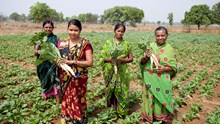
On May 28, 2025, the Cabinet Committee on Economic Affairs, chaired by Prime Minister Narendra Modi, approved an increase in the Minimum Support Prices (MSP) for 14 Kharif crops for the 2025–26 marketing season. This step aims to ensure remunerative prices for farmers, in line with the Union Budget 2018–19 announcement of fixing MSPs at least 1.5 times the all-India weighted average cost of production.
Among the crops, nigerseed recorded the highest increase in MSP with a rise of Rs 820 per quintal, followed by ragi (Rs 596), cotton (Rs 589), and sesamum (Rs 579). These increases are part of the government’s broader strategy to encourage the cultivation of pulses, oilseeds, and nutri-cereals or “Shree Anna,” which offer nutritional value and better income opportunities for farmers.
The highest expected margin over the cost of production is for bajra at 63%, followed by maize and tur at 59%, urad at 53%, while all other crops have a margin of 50%. For example, the MSP for common paddy has increased from Rs 2300 to Rs 2369 per quintal, offering a margin of 81% over its production cost of Rs 1310. Similarly, the MSP for maize is Rs 2400, and for tur/arhar it is Rs 8000 per quintal.
The decision is backed by impressive procurement data. From 2014–15 to 2024–25, paddy procurement rose to 7,608 lakh metric tonnes (LMT), compared to 4,590 LMT between 2004–05 and 2013–14. For all 14 Kharif crops, procurement reached 7,871 LMT during 2014–15 to 2024–25, up from 4,679 LMT in the previous decade.
MSP payments have also surged, paddy farmers received Rs 14.16 lakh crore in the last decade, compared to Rs 4.44 lakh crore earlier. Across all Kharif crops, the total MSP payout rose to Rs 16.35 lakh crore from Rs 4.75 lakh crore.
















